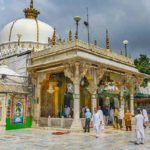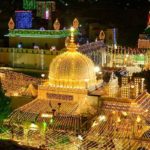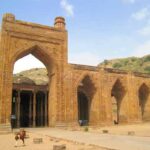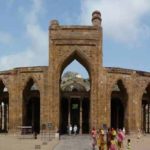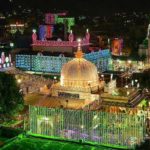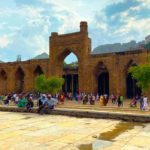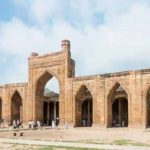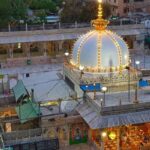Places to See in Ajmer, a city in Rajasthan, is rich in history, culture, and spirituality. The city is most famous for the Ajmer Sharif Dargah, the tomb of the revered Sufi saint Khwaja Moinuddin Chishti. Pilgrims from all over the world visit this holy site to seek blessings.
Another prominent attraction is Ana Sagar Lake, a beautiful artificial lake offering a serene escape and picturesque views. The nearby Daulat Bagh gardens are perfect for a relaxing stroll.
Adhai Din Ka Jhonpra is a remarkable example of early Indo-Islamic architecture. Originally a Sanskrit college, it was converted into a mosque in the 12th century and is known for its intricate carvings.
Taragarh Fort offers stunning views of the city and is a reminder of Ajmer’s historical significance. The fort is also known as the “Star Fort” due to its location on a hilltop.
Nareli Jain Temple is a modern addition to Ajmer’s attractions, known for its unique architecture and peaceful ambiance.
Finally, don’t miss the Akbari Fort & Museum, which showcases Mughal and Rajput art and architecture.
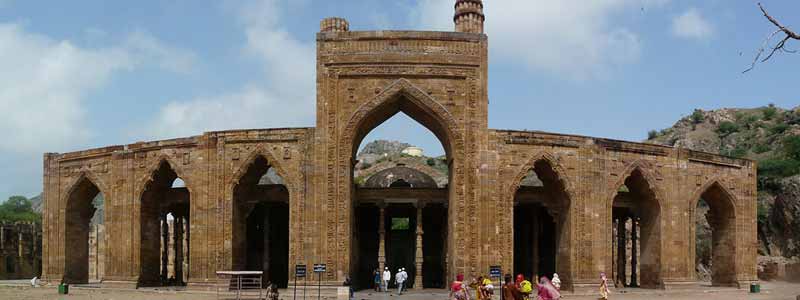
Adhai Din Ka Jhonpra
Adhai Din Ka Jhonpra is one of Ajmer’s most iconic historical monuments, known for its unique architectural blend of Hindu and Islamic styles. Situated near the Ajmer Sharif Dargah, this ancient structure has a fascinating history that dates back to the 12th century.
Originally constructed as a Sanskrit college in 1153 AD, the building was converted into a mosque by Qutb-ud-Din Aibak, the first Sultan of Delhi, in 1192 AD following his conquest of Ajmer. The name “Adhai Din Ka Jhonpra,” which translates to “shed of two and a half days,” is believed to refer to the incredibly short time—just two and a half days—in which the mosque was supposedly built, although some suggest the name might refer to a two-and-a-half-day fair held nearby.
The mosque is renowned for its stunning architecture, featuring an open courtyard, a prayer hall, and a series of beautifully carved arches and pillars. The intricate carvings on the pillars and arches are a blend of floral and geometric patterns, a hallmark of early Indo-Islamic architecture. The mihrab, or prayer niche, is adorned with exquisite calligraphy, showcasing verses from the Quran.
Despite being partially in ruins, Adhai Din Ka Jhonpra remains a significant historical site, symbolizing the cultural and architectural syncretism of medieval India. Its enigmatic name and rich history make it a must-visit for anyone exploring Ajmer.
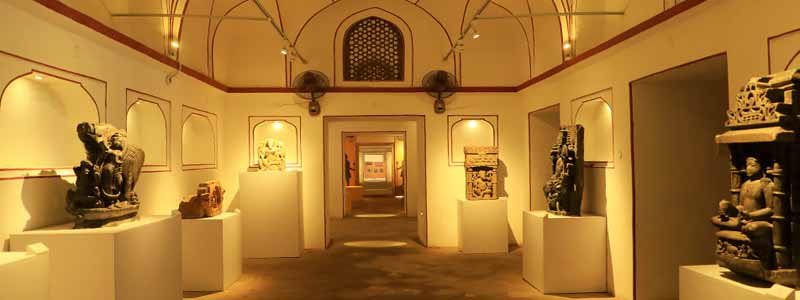
Ajmer Government Museum
The Ajmer Government Museum, also known as the Ajmer Government Archaeological Museum, is a prominent museum located within the historic Akbari Fort in Ajmer, Rajasthan. Established in 1908 by the British government, the museum was created to preserve and display the rich historical and cultural heritage of the region.
Housed in the Akbari Fort, which itself was constructed by Emperor Akbar in 1570 AD, the museum offers visitors a fascinating glimpse into the history of Rajasthan. The museum’s collection includes a wide range of artifacts, including ancient sculptures, inscriptions, miniature paintings, and weaponry.
The museum is divided into several sections, each dedicated to different themes. The Sculpture Gallery showcases a vast collection of stone sculptures from different periods, primarily from Hindu and Jain traditions. The Arms and Armory Gallery displays an impressive array of weapons used by the Rajputs and Mughals, reflecting the martial history of the region.
The Painting Gallery features exquisite miniature paintings from the Mughal and Rajput eras, highlighting the artistic finesse of these periods. Additionally, the museum houses rare manuscripts and coins, offering a comprehensive view of the region’s historical development.
The Ajmer Government Museum is a must-visit for history enthusiasts and those interested in exploring the rich cultural legacy of Rajasthan.
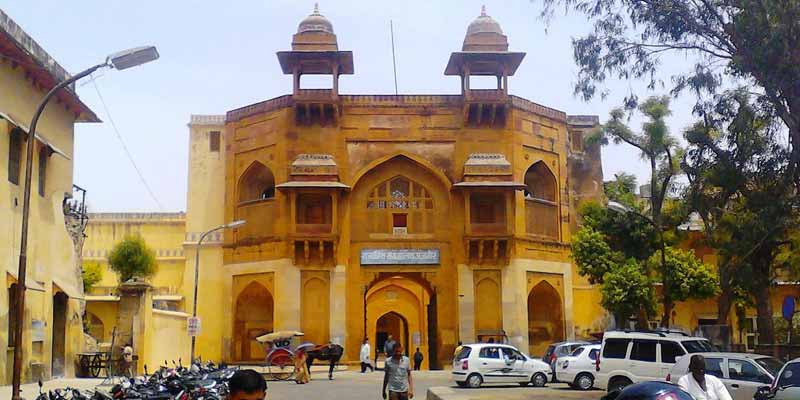
Akbari Fort & Museum
Akbari Fort & Museum, located in Ajmer, Rajasthan, is a significant historical site that showcases the rich cultural heritage of the region. The fort was built by the Mughal Emperor Akbar in 1570 AD and served as a royal residence for the emperor during his visits to Ajmer. It also played a crucial role as a military stronghold, strategically located to oversee the region.
The fort is an excellent example of Mughal architecture, characterized by its massive gates, thick walls, and intricate detailing. The architecture reflects the grandeur and opulence of the Mughal era, with a blend of Persian and Indian design elements.
In 1908, the fort was converted into a museum by the British government to preserve and exhibit the region’s archaeological and historical artifacts. Today, the Ajmer Government Museum, housed within the Akbari Fort, displays an impressive collection of artifacts, including ancient sculptures, inscriptions, miniature paintings, and weapons. The museum is divided into several galleries, each dedicated to different aspects of the region’s history.
The Sculpture Gallery features a vast collection of stone sculptures from different periods, primarily from Hindu and Jain traditions. The Arms and Armory Gallery showcases an array of weapons used by the Rajputs and Mughals, reflecting the martial history of Rajasthan. The Painting Gallery displays exquisite miniature paintings from the Mughal and Rajput eras, highlighting the artistic achievements of these periods.
In addition to its historical significance, the Akbari Fort & Museum offers visitors a glimpse into the artistic and cultural evolution of Rajasthan. The fort’s strategic location and architectural beauty, combined with the rich collection of artifacts in the museum, make it a must-visit destination for history enthusiasts and tourists alike.
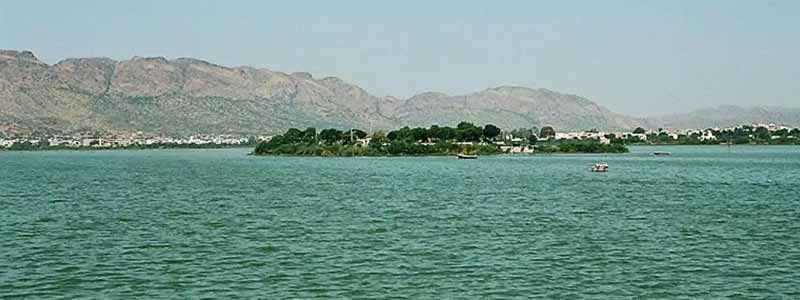
Ana Sagar Lake Ajmer
Ana Sagar Lake is one of the most beautiful and serene attractions in Ajmer, Rajasthan. This large artificial lake was built in the 12th century by Anaji Chauhan, the grandfather of the legendary Prithviraj Chauhan, who was a ruler of the Chauhan dynasty. The lake is named after its creator, Anaji.
Spanning over 13 kilometers, Ana Sagar Lake is a popular spot for both locals and tourists seeking a peaceful escape. The lake is surrounded by lush gardens and offers stunning views of the surrounding hills and the city. One of the highlights of the lake area is the Daulat Bagh, a beautiful garden built by Mughal Emperor Jahangir. The garden is dotted with marble pavilions, known as Baradaris, which were added later by Emperor Shah Jahan, providing a perfect place to relax and enjoy the view.
During the winter months, the lake attracts a variety of migratory birds, making it a favorite spot for birdwatchers. Boating on the lake is a popular activity, allowing visitors to enjoy the tranquil waters and picturesque surroundings.
In the evening, the lake becomes a hub of activity, with locals and tourists gathering to witness the beautiful sunset. The reflection of the setting sun on the lake’s surface creates a mesmerizing scene that is a must-see.
Ana Sagar Lake is not just a natural wonder but also a historic site that reflects Ajmer’s rich cultural heritage. Its beauty and serenity make it one of the most cherished spots in the city.
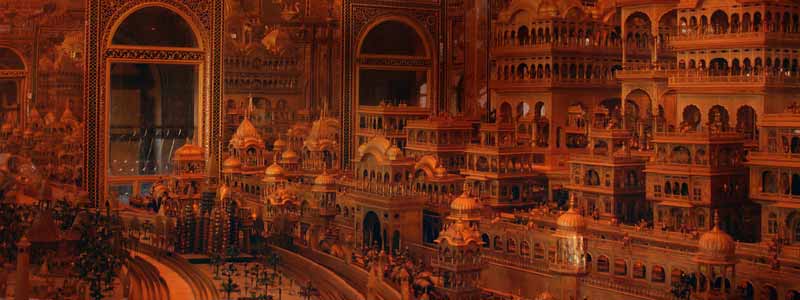
Nasiyan Red Temple
The Nasiyan Red Temple, also known as the Ajmer Jain Temple or Soni Ji Ki Nasiyan, is a magnificent Jain temple located in Ajmer, Rajasthan. Dedicated to Lord Rishabhdev, the first Tirthankara of the Jain religion, this temple is renowned for its stunning architecture and intricate interior.
Constructed in 1865, the Nasiyan Red Temple is named after its striking red sandstone façade. The temple is divided into two main parts: the worship area, which is a simple yet elegant structure used for daily prayers, and the Swarna Nagari (City of Gold), which is a museum-like section that is the main attraction.
The Swarna Nagari is a grand hall filled with an elaborate display of gold-plated wooden figures, depicting scenes from Jain mythology, specifically the story of the Jain concept of the universe and the life of Lord Rishabhdev. This display is crafted with immense detail and features gold, silver, precious stones, and other metals, making it a mesmerizing sight.
The diorama in the Swarna Nagari is a visual feast, showcasing intricately designed palaces, chariots, elephants, and figures that represent various aspects of Jain cosmology. The entire hall is adorned with mirrors and glasswork, enhancing the opulence of the display.
The Nasiyan Red Temple is not only a place of worship but also an architectural and artistic marvel, drawing visitors from all over the world. Its unique blend of religious significance and artistic grandeur makes it one of the must-visit attractions in Ajmer.
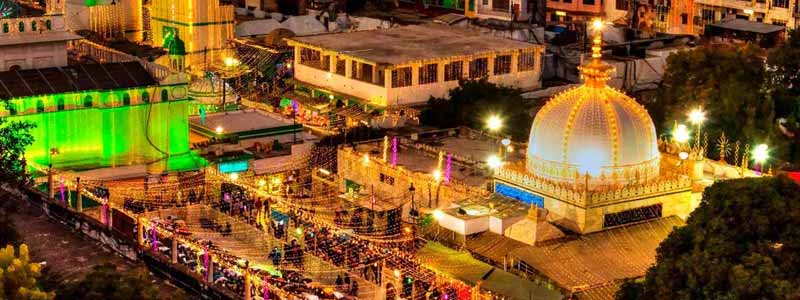
Khawaja Gharibnawaz Dargah Ajmer
The Khawaja Gharibnawaz Dargah in Ajmer, also known as the Ajmer Sharif Dargah, is one of the most revered Sufi shrines in India. It is the final resting place of Khawaja Moinuddin Chishti, a 12th-century Sufi saint who is also known as Gharib Nawaz, meaning “Benefactor of the Poor.” The dargah is a major pilgrimage site for people of all faiths, who come to seek blessings and pay homage to the saint.
Located at the foot of the Taragarh Hill, the Dargah is a complex of white marble buildings, including the saint’s tomb, mosques, courtyards, and gateways. The tomb itself is a stunning example of Mughal architecture, with its intricate carvings, golden dome, and a beautiful marble screen that surrounds the saint’s grave. The tomb chamber is usually adorned with floral offerings and chadars (sacred cloths) brought by devotees.
The Nizam Gate and Buland Darwaza are the main entrances to the dargah complex. Upon entering, visitors pass through several courtyards, each filled with pilgrims offering prayers and donations. The Shah Jahan Mosque, located within the complex, is another architectural marvel, built by the Mughal Emperor Shah Jahan with delicate white marble and detailed work.
The Dargah is especially vibrant during the annual Urs festival, which commemorates the death anniversary of Khawaja Moinuddin Chishti. Thousands of devotees gather during this time, participating in prayers, qawwali (Sufi devotional music), and other religious activities. The atmosphere is filled with devotion, as people from various walks of life come together in unity.
Khawaja Gharibnawaz Dargah is not just a religious site but also a symbol of peace, love, and harmony. Its spiritual significance, combined with its historical and architectural beauty, makes it one of the most important and visited places in Ajmer.
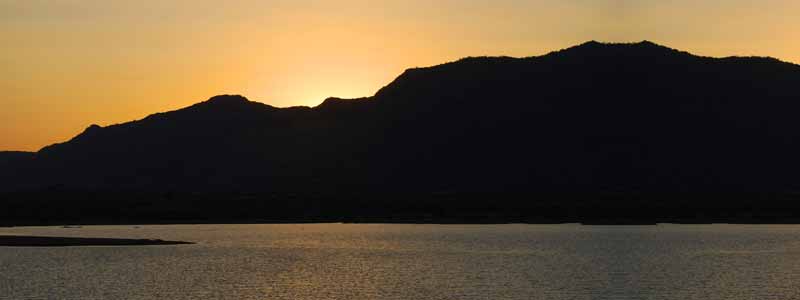
Lake Foy Sagar
Lake Foy Sagar is a picturesque artificial lake located in Ajmer, Rajasthan. Created in 1892 by the British engineer Sir Foy, this lake was built to provide water for the city and its surrounding areas. It is named after Sir Foy, who was instrumental in its construction.
The lake is situated on the outskirts of Ajmer and is known for its serene and tranquil environment, making it a popular spot for relaxation and leisurely activities. It is surrounded by hills and offers a peaceful retreat from the hustle and bustle of the city.
The lake’s scenic beauty is enhanced by its calm waters and the lush greenery that surrounds it. It is an excellent spot for picnicking, walking, or simply enjoying the view of the surrounding landscape. The lake also provides a great vantage point to witness stunning sunsets, adding to its appeal, Places to See in Ajmer.
Birdwatching is another popular activity at Lake Foy Sagar, as the area attracts various bird species, especially during the migratory season. The lake’s peaceful setting and natural surroundings make it a favorite among nature enthusiasts and photographers.
While Lake Foy Sagar is not as well-known as some of the other lakes in Rajasthan, its charm and beauty make it a worthwhile visit for those exploring Ajmer. Its tranquil atmosphere and scenic views provide a refreshing escape and a chance to experience a different side of the city.
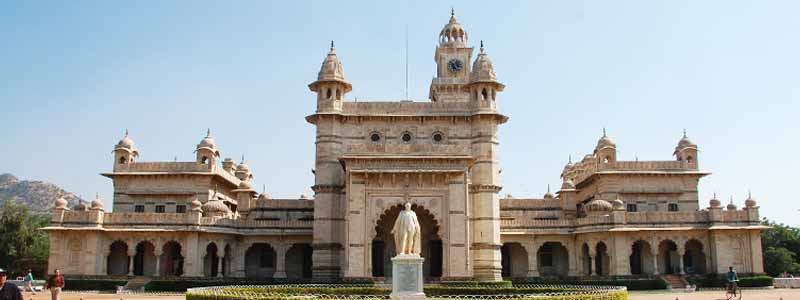
Mayo College Museum
The Mayo College Museum in Ajmer, located within the historic Mayo College campus, is a fascinating repository of the region’s rich heritage. Established in 1875, Mayo College is one of the oldest residential schools in India, and the museum reflects its long history and educational legacy.
The museum showcases an array of artifacts, including ancient sculptures, inscriptions, and historical relics, providing insights into the art and culture of Rajasthan. Key exhibits include exquisite Jain and Hindu sculptures, coins, and manuscripts that highlight the region’s artistic and historical evolution.
One of the museum’s notable features is its collection of weapons and military artifacts, which offer a glimpse into the martial history of the region. Additionally, the museum houses a collection of traditional Rajput and Mughal artwork, including miniature paintings and textiles.
Visitors to the Mayo College Museum can also explore the well-preserved architectural elements of the college itself, which reflect British colonial and Rajput influences. The museum serves as an educational resource and a tribute to the cultural heritage of Ajmer and Rajasthan.
Nareli Jain Temple
The Nareli Jain Temple, also known as the Nareli Digambar Jain Temple, is a prominent and modern Jain temple located on the outskirts of Ajmer, Rajasthan. Dedicated to Lord Rishabhdev, the first Tirthankara of Jainism, the temple is known for its unique architectural style and serene ambiance.
Built in the early 1990s, the Nareli Jain Temple is distinctive for its blend of contemporary and traditional design elements. The temple complex includes several intricately carved shrines, each dedicated to different Tirthankaras. The main shrine houses a beautifully sculpted idol of Lord Rishabhdev.
The temple’s architecture features a combination of white marble and intricate carvings, creating a visually striking contrast against the surrounding desert landscape. The serene setting and the surrounding gardens add to the temple’s tranquil atmosphere, making it a peaceful place for meditation and worship.
In addition to its architectural beauty, the temple is also known for its well-maintained facilities and its role in promoting Jain culture and values. It attracts visitors from across the country and is an important center for the Jain community in Places to See in Ajmer.
Daulat Bagh Garden
Daulat Bagh Garden is a picturesque and historic garden located near the Ana Sagar Lake in Ajmer, Rajasthan. Originally built by the Mughal Emperor Jahangir in the early 17th century, the garden is known for its lush greenery and scenic beauty.
The garden features a well-maintained landscape with manicured lawns, vibrant flower beds, and serene water features. Its most notable elements are the Baradaris (pavilions) made of white marble, which were constructed during the Mughal era. These pavilions offer stunning views of Ana Sagar Lake and are perfect for leisurely strolls and relaxation, Places to See in Ajmer.
Daulat Bagh Garden is a popular spot for both locals and tourists, providing a tranquil escape from the hustle and bustle of the city. The garden’s serene environment makes it an ideal location for picnics, evening walks, and enjoying the sunset over the lake.
The garden’s historical significance, combined with its natural beauty, makes Daulat Bagh a must-visit attraction in Ajmer. Its well-preserved Mughal architecture and picturesque setting offer a glimpse into the region’s regal past and provide a peaceful retreat amidst nature.

